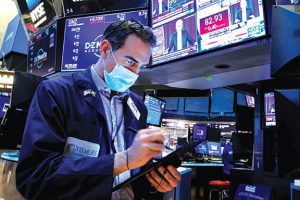Bloomberg
Global stocks and equity futures tumbled while bonds and oil soared as Russian President Vladimir Putin’s decision to order a military attack on Ukraine cast a pall over global markets.
S&P 500 and Nasdaq 100 contracts slid about 1.7% and 2.3% respectively, signalling the latter, tech-heavy gauge faces a bear market. The Stoxx 600 Europe index shed some 2.5% and Asian equities fell to the lowest since 2020. Russian shares slumped the most on record after a trading suspension ended.
Russian forces assaulted targets across Ukraine after Putin ordered an operation aimed at demilitarising the country. Putin said Russia doesn’t plan to “occupy†its neighbor but that action was necessary after the US and its allies crossed Russia’s “red line†by expanding the Nato alliance.
Western powers condemned the military incursion and vowed to step up penalties on Russia — President Joe Biden said the US and its allies will impose “severe sanctions.†The government in Kyiv called it a “full-scale invasion†as it declared martial law and called for international support including harsher sanctions on Russia.
Crude and European natural gas surged on possible risks to Russian energy exports, with Brent oil scaling $100 a barrel for the first time since 2014. The flight to safety saw the US 10-year Treasury yield fall to 1.9%. Gold hit the highest since early 2021.
The dollar and yen jumped, while the euro and commodity-linked currencies retreated.
The ruble reached a record low versus the greenback
and the Bank of Russia said it will conduct foreign-exchange interventions.
The cost of everything from oil to grains to metals has ballooned on worries that raw-material flows will be disrupted by the unfolding crisis.
Ukraine is a major grain exporter and sanctions could isolate Russia, a commodity powerhouse.
That backdrop heralds fresh challenges for a global recovery that was already struggling with elevated price pressures and tightening monetary policy.
“The pressure on energy prices will increase significantly and will add to the risks
of higher prices,†Carsten Roemheld, Fidelity International’s market strategist, said.
Markets pared back bets on rate increases by the Federal Reserve in 2022, with about six 25-basis-point hikes expected. Investors remain worried that Fed tightening could choke the expansion in the world’s largest economy.
The escalation by Russia “will spur further risk-off moves into safe-haven assets, considering that the situation will remain volatile with retaliation measures coming from Western powers,†said Jun Rong Yeap, a strategist at IG Asia Pte, adding “upside risks to inflation just got elevated.â€
In cryptocurrencies, Bitcoin slid to about $35,000 amid risk aversion. Second-largest token Ether also suffered heavy losses as the most speculative areas of markets were worst hit.
The “short-term shock on risk assets†may be short-lived, said Fidelity International’s Roemheld. “In such events usually when the first shock is digested we are going to see a continuation of what was the main theme before and that was inflation.â€
EIA crude oil inventory report is expected on Thursday. US new home sales, GDP, initial jobless claims to be out on Thursday.
Futures on the S&P 500 fell 1.7% in New York. Futures on the Nasdaq 100 fell 2.3%. Futures on the Dow Jones Industrial Average fell 1.8%. The Stoxx Europe 600 fell 2.6%. The MSCI World index fell 1.2%.
The Bloomberg Dollar Spot Index rose 0.4%. The euro fell 0.5% to $1.1248. The British pound fell 0.6% to $1.3462. The Japanese yen rose 0.2% to 114.73 per dollar.
The yield on 10-year Treasuries declined nine basis points to 1.90%. Germany’s 10-year yield declined six basis points to 0.16%. Britain’s 10-year yield declined seven basis points to 1.41%.
West Texas Intermediate crude rose 6.5% to $98.07 a barrel. Gold futures rose 1.7% to $1,942.80 an ounce.
 The Gulf Time Newspaper One of the finest business newspapers in the UAE brought to you by our professional writers and editors.
The Gulf Time Newspaper One of the finest business newspapers in the UAE brought to you by our professional writers and editors.
